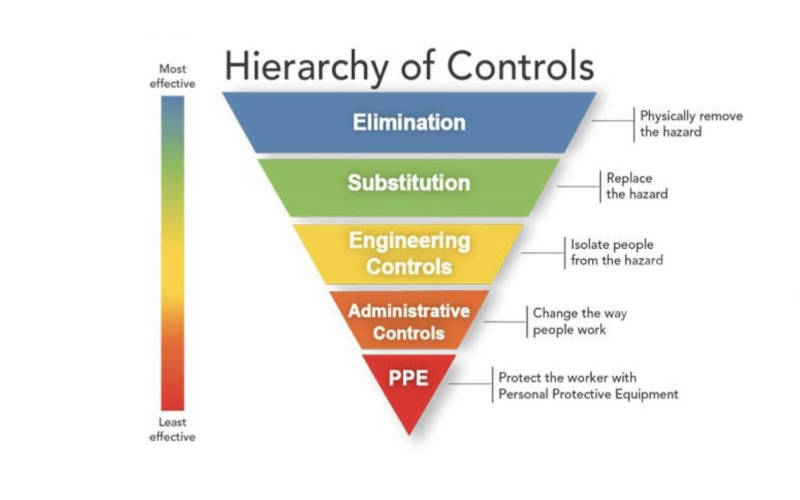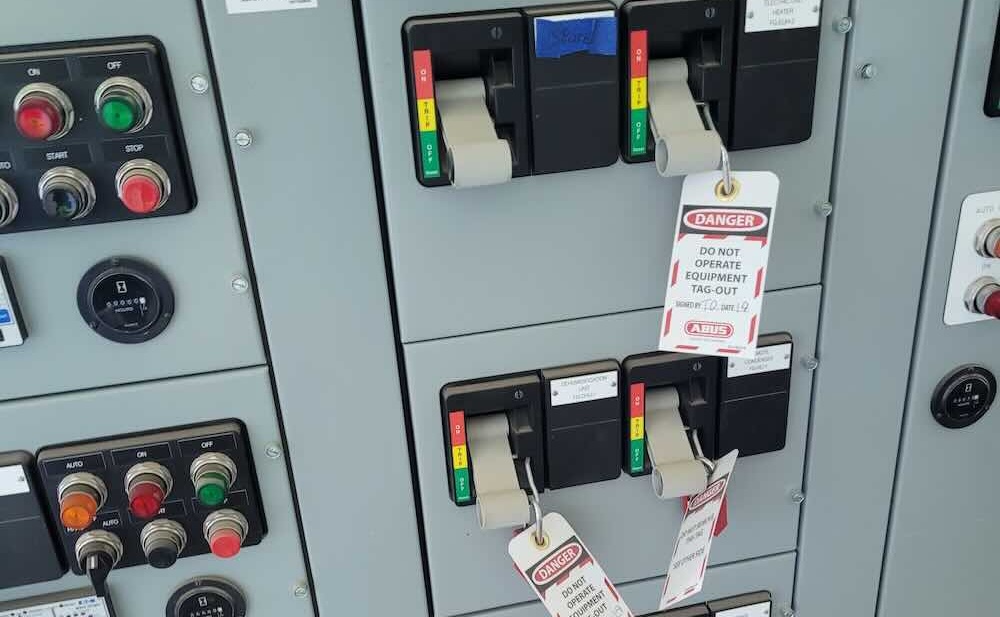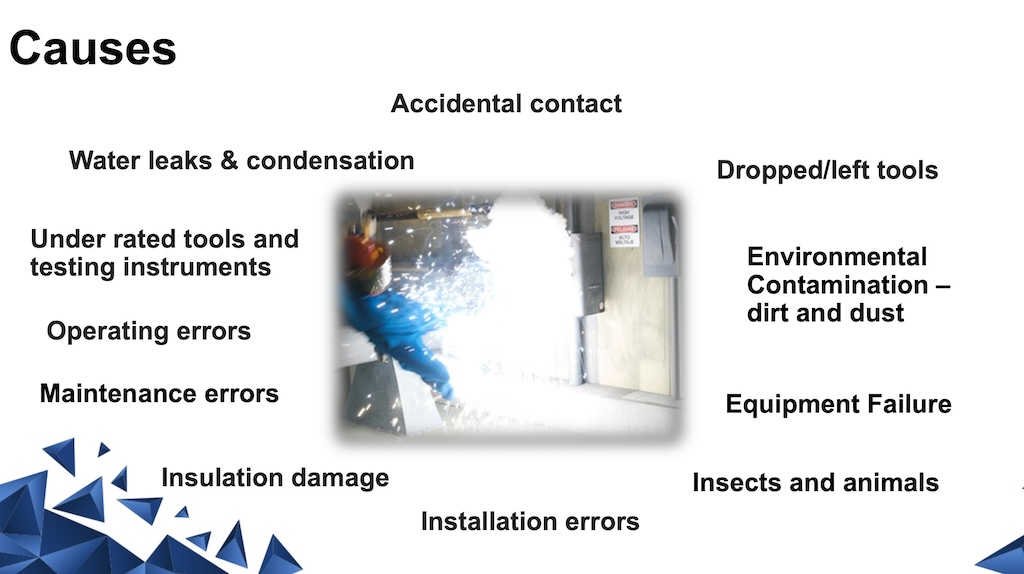An arc flash analysis (sometimes referred to as a flash hazard analysis) is a thorough and careful mathematical model of a facility’s electrical power distribution and control system. The purpose of this electrical system study is to determine as accurately as possible how the electrical system will respond to faults that might occur at various points within the system.
An arc flash analysis (sometimes referred to as a flash hazard analysis) is a thorough and careful mathematical model of a facility’s electrical power distribution and control system. The purpose of this electrical system study is to determine as accurately as possible how the electrical system will respond to faults that might occur at various points within the system.
The analysis considers the potential of high-magnitude faults such as bolted faults and arcing faults. These short-circuit conditions can potentially damage the system. Arcing faults are especially dangerous to any personnel who may be in the proximity of the arcing event, such as a worker who is working on electrical equipment while it is energized. The hazards to personnel resulting from arcing faults are well documented, and safety standards and work practices are in place to help protect workers from arc flash hazards.
A properly executed arc flash analysis also will consider the ability of the system to respond to other less damaging events such as overcurrent conditions, and will predict how the overcurrent-protective system will respond to those occurrences. Operation of an overcurrent-protective device due to an overcurrent condition or another anomaly will interrupt the electrical supply and may disrupt processes in the plant, but will not normally damage the system or pose a safety risk to personnel.
An arc flash analysis must be performed only by electrical engineers who are familiar with power system design and the techniques of conducting these complex system studies. Considerable knowledge and experience is required for this work and judgment will play a key role as various choices are made by the engineer during the course of the analysis. Commercially available software is used by the engineer to perform the complex calculations, and several companies provide a high-quality product that can produce a quality result.
Standards
Arc flash analysis is required by Article 130.3 of the electrical safety standard NFPA 70E 2004 — Standard for Electrical Safety in the Workplace in article 130.3. For most pieces of electrical equipment in a facility under study, several of the most critical pieces of information that will be calculated or provided relate to the hazards to which a worker might be exposed when the decision is made to work on the equipment while it is in an electrically energized condition.
The recognized hazards as addressed in NFPA 70E are shock, electrocution, arc flash and arc blast. For shock hazards, it is adequate to know the operating voltage of the equipment, working distance and three approach boundaries called limited approach, restricted approach and prohibited approach. These important boundaries define limits in inches from the nearest energized parts for shock protection.
For protection from arc flash and arc blast hazards, two other variables are calculated in the analysis. These two calculated results are called the flash protection boundary and the incident energy in calories per square centimeter. The flash protection boundary is defined (in NFPA 70E 2004 Article 100 definitions) as “an approach limit at a distance from exposed live parts within which a person would receive a second degree burn if an electrical arc flash were to occur.” Incident energy is the measure of the heat that is released in the arc flash in calories per square centimeter and it defines the personal protective equipment (PPE) class that the worker must wear for arc flash protection.
The shock and flash protection boundaries generally define that only a qualified person is permitted to be within these boundaries if energized parts are exposed and that person must be trained on the hazards and properly protected from them.
Qualifying service providers
A properly conducted arc flash analysis is really a composite of three electrical system studies: the short circuit study, time-current coordination study and the arc flash analysis itself. For a typical arc flash analysis, the short circuit and coordination studies together comprise approximately 90% of the total cost of the analysis. Cost for the entire arc flash analysis can range from several thousand dollars in a fairly small industrial facility to tens of thousands of dollars and even more in larger buildings and multi-building campuses.
Arc flash hazard analysis is a fairly recent phenomenon. Formulas for calculating arc flash hazard potential did not exist at all until the late 1990s, and this requirement first appeared in the 2000 edition of NFPA 70E. IEEE 1584 2002 Guide for Performing Arc Flash Hazard Calculations is the definitive document that provides guidance to engineering professionals on the techniques of arc flash hazard analysis. IEEE 1584 is an excellent resource for establishing the standards for arc flash hazard analysis. Many commercial vendors can provide a very high-quality scope of work at a reasonable cost.
Because this is a relatively new requirement and technology, few people other than licensed electrical engineers who are experienced in this art really understand how these analyses should be done. At the same time, the NFPA 70E and OSHA requirements apply to tens of millions of facilities in the United States alone, and many of these facilities are struggling to achieve compliance with electrical safety standards. The large market demand and confusion, coupled with a relatively small field of qualified companies who understand how to perform these studies properly, is spawning many opportunistic enterprises that seek to take advantage of the market dynamics for a short term gain and may deliver a substandard product or result.
For facility managers and other professionals who are responsible for qualifying and selecting vendors to perform this important work, it is a dangerous course to navigate, fraught with hazards and obstacles. The cost of quality work that is required to perform these analyses correctly is fairly significant. In a competitive-bid situation, the low price may be the incorrect choice unless a high degree of scope qualification and specification is applied in the vetting process. Having a complete specification that outlines the requirements and expectations for the work will help protect the purchaser from substandard vendors.
What follows are several considerations for qualifying vendors for arc flash analyses:
-
Arc flash analysis scope shall include complete short circuit and time-current coordination studies
-
Arc flash analysis shall be performed by a licensed, registered professional electrical engineer
-
Proposed vendor shall have at least 10 years of experience in performing power system studies including at least four years of experience in providing arc flash analyses
-
Vendor shall provide names of at least 10 facilities for which they have provided arc flash analyses in the past 12 months
-
Vendor shall include a line item in the quote to provide equipment labels with detailed incident energy values and required PPE categories taken from the arc flash study calculations. These labels shall conform to ANSI Z535.4 and UL969, and shall meet the requirements of all applicable standards
-
The arc flash analysis shall contain recommendations for reducing high arc flash incident energy levels where they are found, to enhance worker safety
-
A computer-generated system one-line diagram will be completed that clearly identifies individual equipment buses, bus numbers used in the short circuit analysis, cable and bus connections between the equipment, calculated maximum short circuit current at each bus location and other information pertinent to the computer analysis.
-
(Source: Section 16000-1 Electrical System Studies, available from Square D Services.)
Some facilities may choose to use internal engineering resources to perform this work. If these resources are available, they are often a good choice. However, unless the engineers are familiar with the techniques of arc flash analysis, it may be necessary to provide some additional training on the techniques of arc flash analysis. Several companies exist for the sole purpose of training engineers on performing arc flash analysis and provide a high level of service and counsel.
One caveat to this option, however, is that most engineers will significantly underestimate the time required to complete the analysis, unless they have had prior experience. They may also substantially underestimate the time required for field data collection. Data collection is required in most facilities to document the electrical system components and settings where accurate drawings and other reliable documents are not available. Thus, flexibility in the estimate of project duration and cost is prudent.
Making the choice
Purchasing an arc flash analysis for an industrial facility is very important for electrical safety standard compliance and also is required in order to provide the safest possible workplace for employees. However, like any product or service, when purchasing an arc flash analysis, one tends to get what one pays for, which is why qualifying providers should not be taken lightly. But more importantly, a facility owner or manager should also be careful not to be wooed by low bids.
Thus, a careful and thoughtful approach to an arc flash analysis purchase and qualifying providers, can help ensure the best possible result for a company’s investment.
Author Information Joseph Weigel is a product manager for



